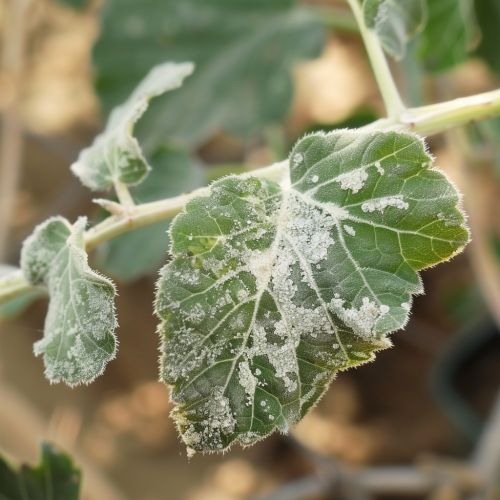Plant Diseases
Introduction
Plant diseases are a significant threat to agriculture, horticulture, and forestry, affecting the health and productivity of plants. These diseases are caused by a variety of pathogens, including fungi, bacteria, viruses, nematodes, and parasitic plants. Understanding the mechanisms of plant diseases, their symptoms, and control methods is crucial for managing and mitigating their impact.
Types of Plant Diseases
Fungal Diseases
Fungal diseases are among the most common and destructive plant diseases. Fungi can infect plants through spores that are spread by wind, water, soil, or insects. Some notable fungal diseases include:
- **Powdery Mildew**: Characterized by white, powdery spots on leaves and stems, this disease affects a wide range of plants, including cereals, vegetables, and ornamentals.
- **Rusts**: These diseases cause reddish or brownish pustules on leaves and stems. Rusts are particularly problematic for cereal crops like wheat and barley.
- **Blights**: Blights cause rapid and extensive damage to plant tissues, leading to wilting and death. A well-known example is the late blight of potatoes and tomatoes, caused by the fungus Phytophthora infestans.


Bacterial Diseases
Bacterial diseases are caused by pathogenic bacteria that invade plant tissues, often through wounds or natural openings. Key bacterial diseases include:
- **Bacterial Wilt**: This disease, caused by Ralstonia solanacearum, leads to wilting and death of plants such as tomatoes, potatoes, and bananas.
- **Fire Blight**: Affecting apple and pear trees, fire blight is caused by Erwinia amylovora and results in blackened, wilted branches and fruit.
- **Crown Gall**: Characterized by tumor-like growths on roots and stems, this disease is caused by Agrobacterium tumefaciens.
Viral Diseases
Viruses are submicroscopic pathogens that can cause a wide range of symptoms in plants, including mosaic patterns, stunting, and leaf curling. Important viral diseases include:
- **Tobacco Mosaic Virus (TMV)**: This virus causes mottled, discolored leaves and stunted growth in tobacco and other solanaceous plants.
- **Tomato Yellow Leaf Curl Virus (TYLCV)**: Affecting tomatoes, this virus leads to yellowing and curling of leaves, reducing fruit yield.
- **Cucumber Mosaic Virus (CMV)**: CMV infects a variety of plants, causing mosaic patterns on leaves and fruit distortion.
Nematode Diseases
Nematodes are microscopic, worm-like organisms that can cause significant damage to plant roots, leading to stunted growth and reduced yields. Key nematode diseases include:
- **Root-Knot Nematodes**: These nematodes, belonging to the genus Meloidogyne, cause galls or knots on roots, affecting nutrient uptake.
- **Cyst Nematodes**: Cyst nematodes, such as Heterodera and Globodera species, form cysts on roots and disrupt plant growth.
Parasitic Plant Diseases
Parasitic plants derive nutrients from their host plants, often causing significant damage. Notable parasitic plant diseases include:
- **Dodder**: This parasitic plant wraps around its host, extracting nutrients and weakening the host plant.
- **Broomrape**: Broomrape species, such as Orobanche, attach to the roots of host plants and siphon off nutrients, leading to stunted growth and reduced yields.
Disease Mechanisms and Pathogenesis
Understanding the mechanisms of plant diseases involves studying how pathogens infect and cause damage to plants. This includes:
- **Infection Process**: Pathogens enter plants through natural openings (stomata, lenticels) or wounds. Fungi and bacteria often produce enzymes that degrade plant cell walls, facilitating entry.
- **Colonization**: Once inside, pathogens colonize plant tissues, spreading through vascular systems or intercellular spaces.
- **Symptom Development**: Pathogen activity disrupts normal plant functions, leading to symptoms such as chlorosis (yellowing), necrosis (tissue death), wilting, and abnormal growths.
Disease Management and Control
Effective management of plant diseases involves a combination of cultural, biological, and chemical methods. Key strategies include:
- **Cultural Practices**: Crop rotation, sanitation, and proper irrigation can reduce disease incidence. Resistant plant varieties are also crucial in disease management.
- **Biological Control**: Beneficial organisms, such as predatory insects, fungi, and bacteria, can help control plant pathogens.
- **Chemical Control**: Fungicides, bactericides, and nematicides are used to manage plant diseases. However, their use must be carefully managed to avoid resistance development and environmental impact.
Emerging Challenges and Future Directions
The emergence of new plant diseases and the evolution of pathogen resistance pose ongoing challenges. Climate change, global trade, and agricultural practices contribute to the spread and severity of plant diseases. Future research focuses on:
- **Genomic Approaches**: Understanding pathogen genomes and plant immune responses can lead to the development of resistant crops.
- **Integrated Pest Management (IPM)**: Combining multiple control strategies to sustainably manage plant diseases.
- **Biotechnological Advances**: Genetic engineering and CRISPR technology offer potential for developing disease-resistant plants.
